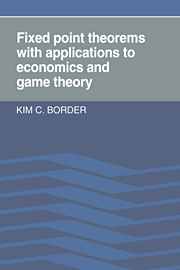Book contents
- Frontmatter
- Contents
- Preface
- 1 Introduction: models and mathematics
- 2 Convexity
- 3 Simplexes
- 4 Sperner's lemma
- 5 The Knaster-Kuratowski-Mazurkiewicz lemma
- 6 Brouwer's fixed point theorem
- 7 Maximization of binary relations
- 8 Variational inequalities, price equilibrium, and complementarity
- 9 Some interconnections
- 10 What good is a completely labeled subsimplex
- 11 Continuity of correspondences
- 12 The maximum theorem
- 13 Approximation of correspondences
- 14 Selection theorems for correspondences
- 15 Fixed point theorems for correspondences
- 16 Sets with convex sections and a minimax theorem
- 17 The Fan-Browder theorem
- 18 Equilibrium of excess demand correspondences
- 19 Nash equilibrium of games and abstract economies
- 20 Walrasian equilibrium of an economy
- 21 More interconnections
- 22 The Knaster-Kuratowski-Mazurkiewicz-Shapley lemma
- 23 Cooperative equilibria of games
- References
- Index
10 - What good is a completely labeled subsimplex
Published online by Cambridge University Press: 16 January 2010
- Frontmatter
- Contents
- Preface
- 1 Introduction: models and mathematics
- 2 Convexity
- 3 Simplexes
- 4 Sperner's lemma
- 5 The Knaster-Kuratowski-Mazurkiewicz lemma
- 6 Brouwer's fixed point theorem
- 7 Maximization of binary relations
- 8 Variational inequalities, price equilibrium, and complementarity
- 9 Some interconnections
- 10 What good is a completely labeled subsimplex
- 11 Continuity of correspondences
- 12 The maximum theorem
- 13 Approximation of correspondences
- 14 Selection theorems for correspondences
- 15 Fixed point theorems for correspondences
- 16 Sets with convex sections and a minimax theorem
- 17 The Fan-Browder theorem
- 18 Equilibrium of excess demand correspondences
- 19 Nash equilibrium of games and abstract economies
- 20 Walrasian equilibrium of an economy
- 21 More interconnections
- 22 The Knaster-Kuratowski-Mazurkiewicz-Shapley lemma
- 23 Cooperative equilibria of games
- References
- Index
Summary
Remark
The proof of Sperner's lemma given in 4.3 suggests an algorithm for finding completely labeled subsimplexes. Cohen [1967] uses the following argument for proving Sperner's lemma. The suggestive terminology is borrowed from a lecture by David Schmeidler. Consider the simplex to be a house and all the n-subsimplexes to be rooms. The completely labeled (n–1)-subsimplexes are doors. A completely labeled n-simplex is a room with only one door. The induction hypothesis asserts that there are an odd number of doors to the outside. If we enter one of these doors and keep going from room to room we either end up in a room with only one door or back outside. If we end up in a room with only one door, we have found a completely labeled subsimplex. If we come back outside there are still an odd number of doors to the outside that we have not yet used. Thus an odd number of them must lead to a room inside with only one door.
The details involved in implementing a computational procedure based on this “path-following” approach are beyond the scope of these notes. An excellent reference for this subject is Scarf [1973] or Todd [1976]. In this chapter we will see that finding completely labeled subsimplexes allows us to approximate fixed points of functions, maximal elements of binary relations, and intersections of sets.
Remark: Completely Labeled Subsimplexes and the K-K-M Lemma
Section 5.3 presents a proof of the K-K-M lemma based on simplicial subdivision and Sperner's lemma.
- Type
- Chapter
- Information
- Publisher: Cambridge University PressPrint publication year: 1985



